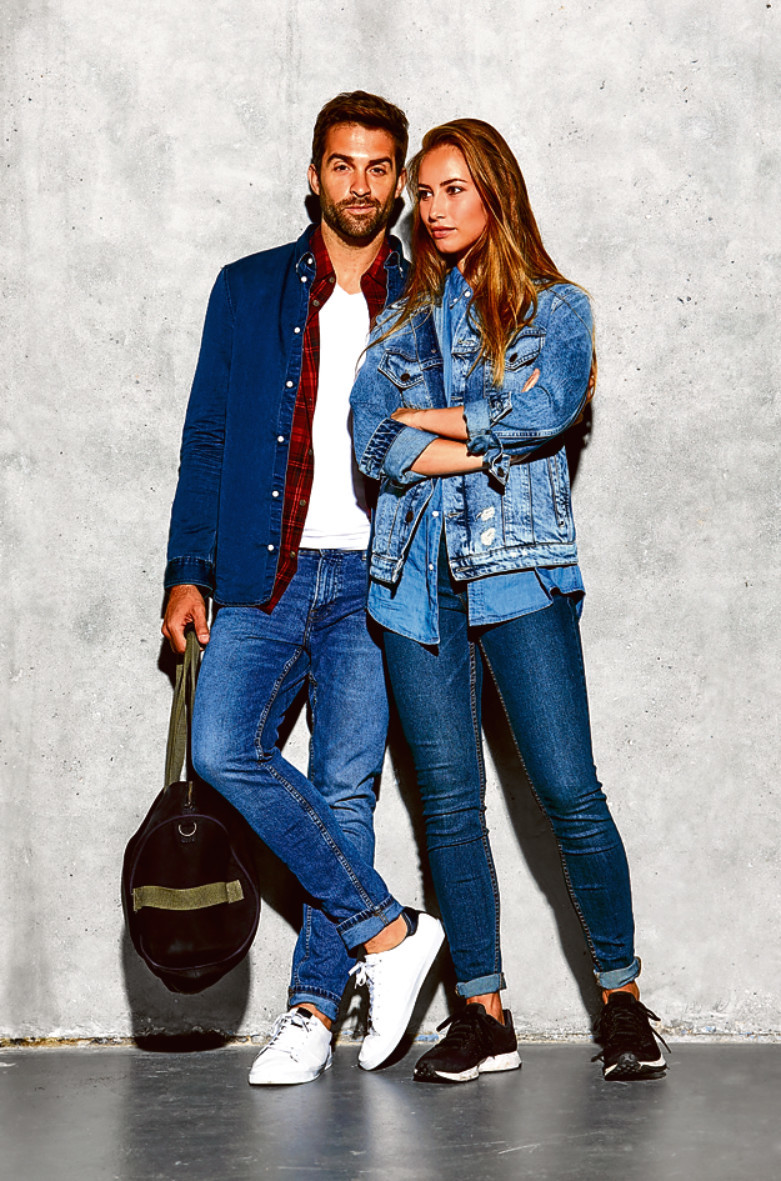
JEANS. We see them on babies, on grannies, on the shop floor, the catwalk and in the boardroom.
Little wonder the annual global jeans market is worth well over $60billion. Mark Zuckerberg, co-founder of Facebook, is rarely seen in anything else.
But how did such purely functional clothing for miners become the world’s favourite garment?
The story begins back in 1872, when a tailor from Reno, Nevada, wrote to the San Francisco supplier of the fabric he used to make tough work trousers for miners.
He’d hit on a way to make them much more durable, but he couldn’t afford to patent his idea so was after a partner. That “dry goods” or textiles supplier was very happy to oblige. His name was Levi Strauss.
The name of the tailor, Jacob Davis, is little known these days, but it was his idea that revolutionised workwear.
He used copper rivets at stress points in garments such as pocket corners to make them much more hard-wearing. His customers loved them.
He made them in both denim and a type of canvas known as brown duck. Fortunately it was the denim that caught on.

On May 20 1873, Jacob and Levi were granted their patent. Jacob had been making them earlier, but this is regarded by Levi Strauss and Co as the birthday of our beloved blue jeans. Back in the 19th Century though, the garments went by the less snappy name of “waist overalls”!
They were exactly what the miners and cowboys of the West needed.
There were no belt loops but buttons for braces. A small cinch belt at the back prevented gaping, and they were made of extra-strong denim.
The word denim derives from the cloth “serge de Nimes” though this version was woven in America not France. Two shades of thread are used, which is why your denims are paler inside.
Indigo was the colour of choice because, frankly, it hides the muck. That may explain a lot about its popularity to this day!
By 1886, Levi Strauss, with Davis as supervisor, had a thriving manufacturing business and introduced their distinctive leather patch featuring two horses attempting to tear apart a pair of their waist overalls.
“It’s no use. They can’t be ripped,” claimed the strapline. Of course they can, but such poetic license was fine in 1886 advertising.
Four years later, the name 501s was applied to the riveted denims.
Many of the company’s earliest records were destroyed in the San Francisco earthquake and fire of 1906. Company relics pre-dating this time are highly prized, which explains an expensive shopping day for the company in 2002, when it bought back at auction a pair of its own jeans dating from 1890 for $45,500.
The oldest pair of jeans in the world, they are stored in a fire-proof safe. It is rumoured that only two people know the combination.
By the early 20th Century, with its patent expired, Levi Strauss & Co had competition from companies such as Lee, Oshkosh B’Gos and Wrangler.
In 1926, Lee, based in Kansas, was ahead of Levi’s some 30 years in replacing button flies with zips in its “cowboy pants”.
In 1934, Levi’s made its own innovation — Lady Levi’s, the first jeans in the world designed specifically for women. Again these “overalls” were designed simply as functional workwear, but come the 1950s, all that was set to change.
Kindling had already been laid by many a cowboy film featuring tough guys such as John Wayne and Gary Cooper in their denims. But it was Marlon Brando In The Wild One in 1953, and James Dean in 1955’s Rebel Without A Cause who really set the blaze.
Denim had a new, rebellious allure, and young people in the States and over here were eager to buy into it. Marilyn Monroe and Audrey Hepburn added a cachet that appealed to women.
With their new image, waist overalls acquired a new name — jeans. Denim had sometimes been called “jean”, a term believed to derive from “fustian of Genoa”. Why young people adopted it isn’t known. Perhaps just because it sounds better!
Incredibly it was as late as 1960 before Levi’s followed its market and began advertising its products as jeans.
In subsequent decades, mods, rockers, hippies, punks, goths, rappers and more have all embraced denim. But fashion demands continual change.
We may all love the same material but cut and finish are all. The flared “loons” of the 70s have little but fabric in common with the super-tight skinnies that have inflicted many a varicose vein in recent years.
Among the many other styles are capris, boot cut, cargo, twisted, boyfriend, girlfriend and mom jeans. The latter was an insult applied to the high-waisted, tapered jeans, loose at hip and thigh, supposedly loved by mums in the 1990s.
You’ll see many a youngster out in them now though as they ride a new wave of popularity. See. Mother knows best.
Dad jeans are a recognised if uncelebrated thing too. High-waisted and loose-fitting, they are designed for comfort. Just think Top Gear, old style.
To true denim connoisseurs though it is a genuine “lived-in” quality to their jeans that is all important. The secret is to never, ever wash them!
This harks back to the days when all jeans were made of virgin shrink-to-fit denim that had to be bought at least one size up.
Many will recall sitting in the bath in their new jeans for an hour or two, then waiting for them to dry to their body contours. With wear, a sort of alchemy occurs, transforming the fabric into a second skin unique to the wearer. “Whiskering” or wear lines appear across the hips and the fabric fades naturally at pressure zones like the knees.
These highly-prized effects in both virgin and pre-shrunk denim are ruined by washing, which is deemed an act of barbarism by the many no-wash exponents.
Apparently, if the denims start to pong they can be put in the freezer to kill the bacteria. A gentle rinse in cold water about once a year followed by line drying in just about permissible.
Purists turned a blind eye to this in 1985, however, when model Nick Kamen sauntered into a launderette and stripped to his boxers for that most memorable and oft-parodied Levi’s TV ad.
To the strains of Heard It On The Grapevine, Nick emptied a bag of small rocks into a machine followed by his tee-shirt and jeans, with customers and viewers all agog.
The result? Sales of Levi 501s rocketed by 800%!
Nick’s profile rocketed too.
The following year, he had a Top 10 hit with Each Time You Break My Heart, which was written by Madonna. Unfortunately his singing career, like his jeans, rapidly faded.
Those rocks in the washer signalled something that was here to stay, though. Stone-washed denim had well and truly arrived.
The 80s were boom time for fancy denim finishes.
Fashion just couldn’t hang around for authentic fading, so manufacturers did the work in advance, washing their jeans with pumice stones to create that pre-worn look.
Snow-washed denim followed, achieved by soaking the pumice in bleach, while today, sanding is popular. Bizarre as it sounds, jeans are vigorously hand-finished with sandpaper to soften the denim and give the desired distressed look of long-term wear.
And what of tear?
Perfectly sound denim is ripped and scoured and generally beaten up to emulate years of hard living. But take care. Those knee rips have to be in the right places or they just aren’t fashionable.
What would tailor Jacob Davis have made of that in 1872?
Fashion is a fickle thing.
Denim sales have been in the doldrums of late, sharing the market with even more casual sweatpants and leggings, but in 2018, they are on the up again. The big story from the catwalks is the return to respectability of double denim.
Wearing denim on both your top and bottom halves, as formerly embraced by rockers Status Quo, has been a fashion crime for years.
In America, it’s a look known as the Canadian Tuxedo, thanks to Bing Crosby.
In 1951, the crooner and pals were on a hunting trip when they were turned away as they tried to book into a hotel in Vancouver.
The receptionist didn’t recognise him and turned him away on account of his denims.
A more observant bellboy resolved the mix-up, but Levi Strauss marketing couldn’t miss this opportunity. They had a tuxedo custom made in denim for the famous crooner to ensure it would never happen again. He loved it.
The company reissued a replica version in 2015, and among those who snapped one up was Mr Richard Branson.
There’s a smart tailored suit in trusty “serge de Nimes” in Victoria Beckham’s current off-the-peg range too. At £850, it is out of reach for many office workers but there’s sure to be trickle down to the High Street soon.
Whether you think it’s perfection or pants, denim is definitely here to stay!

Enjoy the convenience of having The Sunday Post delivered as a digital ePaper straight to your smartphone, tablet or computer.
Subscribe for only £5.49 a month and enjoy all the benefits of the printed paper as a digital replica.
Subscribe